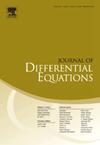Multiple solutions for the nonlinear Schrödinger-Poisson system with a partial confinement
IF 2.3
2区 数学
Q1 MATHEMATICS
引用次数: 0
Abstract
We study the following nonlinear Schrödinger-Poisson system with a partial confinement where and is a parameter. The existence and nonexistence results are established by variational methods, depending on the parameters p and λ. It turns out that is a critical value for the existence of solutions.
Our results can be viewed as an extension of the results of Ruiz [33] concerning the nonlinear Schrödinger-Poisson equation with a positive constant potential. However, due to the presence of partial confinement, the Nehari-Pohozaev manifold method is no longer applicable in this paper for . We need to explore the more complicated underlying functional geometry with a different variational approach. Moreover, we also construct saddle type nodal solutions whose nodal domains meet at the origin.
具有部分约束的非线性Schrödinger-Poisson系统的多解
我们研究了以下非线性Schrödinger-Poisson系统,该系统具有部分约束{−Δu+(x12+x22)u+λ φ (x)u=|u|p−2u,x∈R3,−Δϕ=u2,x∈R3,其中p∈(2,6),λ>;0为参数。根据参数p和λ,用变分方法建立了存在性和不存在性的结果。结果表明,p=3是解存在的临界值。我们的结果可以看作Ruiz[33]关于具有正常数势的非线性Schrödinger-Poisson方程的结果的推广。然而,由于部分约束的存在,对于p∈(3165),本文不再适用Nehari-Pohozaev流形方法。我们需要用不同的变分方法来探索更复杂的底层函数几何。此外,我们还构造了节点域在原点相交的鞍型节点解。
本文章由计算机程序翻译,如有差异,请以英文原文为准。
求助全文
约1分钟内获得全文
求助全文
来源期刊
CiteScore
4.40
自引率
8.30%
发文量
543
审稿时长
9 months
期刊介绍:
The Journal of Differential Equations is concerned with the theory and the application of differential equations. The articles published are addressed not only to mathematicians but also to those engineers, physicists, and other scientists for whom differential equations are valuable research tools.
Research Areas Include:
• Mathematical control theory
• Ordinary differential equations
• Partial differential equations
• Stochastic differential equations
• Topological dynamics
• Related topics

 求助内容:
求助内容: 应助结果提醒方式:
应助结果提醒方式:


